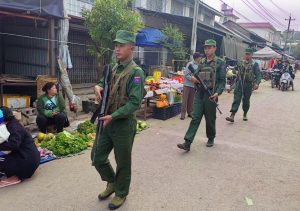Late yesterday, Myanmar social media was abuzz with reports that junta forces in the town of Laukkai had fallen to resistance forces, marking a potential watershed in the nationwide civil war.
Khit Thit, an independent Myanmar news company reported that the Myanmar military’s regional operations command in Laukkai surrendered to the Myanmar National Defense Alliance Army (MNDAA), which has been on the march in northern Shan State since late October.
Laukkai is the capital of the Kokang Self-Administered Zone (SAZ), a sliver of territory along the border with China, which the MNDAA ruled prior to 2009.
While the reports of the surrenders have yet to be confirmed by the MNDAA, there has been a sense of inevitability about the fall of Laukkai since the armed group launched a broad offensive in northern Shan State in late October, along with the Ta’ang Nationa Liberation Army and Arakan Army, its allies in the Three Brotherhood Alliance. Since then, the three groups have made rapid gains across northern Shan, overrunning hundreds of military outposts and seizing key towns and border crossings with China.
While the Alliance has pledged itself to “eradicating the oppressive military dictatorship” that seized power in February 2021, the MNDAA’s proximate goal is to take back control of Kokang, from which it was driven by the Myanmar military in 2009. Since then, the territory has been under the control of a military-backed Border Guard Force (BGF) controlled by a former faction of the MNDAA, in partnership with several Chinese mafia clans that have turned the territory into an epicenter of criminal activity, including massive online scamming operations. Junta and BGF forces have been bottled up in Laukkai for several weeks now, while most people with the means to do so have fled the city, in anticipation of the MNDAA’s final push.
In a post on X (formerly Twitter), Ye Myo Hein, a prominent Myanmar analyst and visiting fellow at the United States Institute of Peace, said that if the reports were true, this would be the first of Myanmar’s seven Regional Operation Commands (ROCs) to fall to resistance forces. In a November report, the Institute for Strategy and Policy, a Yangon-based think tank, stated that the ROC in Laukkai currently includes one division and 13 battalions of soldiers. Ye Myo Hein also cited “unconfirmed reports that the order to surrender came from Naypyidaw,” suggesting that it is part of a retreat from northern Shan State to what the military considers a more defensible line further to the south.
According to the report by Khit Thit, military forces are withdrawing to Lashio, 186 kilometers to the southwest, with their families and a percentage of their military equipment.
The reports of the surrender came just a day after reports that an artillery shell from Myanmar had fallen across the border in the town of Nansan in China’s Yunnan province, which lies around 8 kilometers from Laukkai. The border gate between Nansan and the Kokang SAZ was reportedly seized by MNDAA forces on December 19.
The shell reportedly exploded and caused injuries to multiple people. A video published by Reuters from grainy footage posted to social media appeared to show the impact of the shell, and the aftermath.
Asked about the reports at a regular press briefing on Thursday, Foreign Ministry spokesperson Wang Wenbin said that China “strongly deplores the Chinese casualties caused by the conflict and has already lodged serious representations with the relevant parties.” He added, “China once again asks all parties to the conflict to cease fire and stop fighting, and take measures to prevent the recurrence of such vicious incidents.”
The surrender report also coincided with Myanmar’s Independence Day, which the military administration marked with a ceremonial release of some 9,000 prisoners. Among them were 114 foreign nationals and the jailed photojournalist Kaung Sett Lin, who was sentenced in December 2022 to three years of hard labor. The model Nang Mwe San and actress Thinzar Wint Kyaw, both imprisoned for anti-coup activities, were reportedly also freed.
However, neither this customary show of clemency nor junta chief Min Aung Hlaing’s delusional Independence Day speech should detract from the extent of the defeat that the military has suffered in the north of the country. Even if the reports are wrong and Laukkai has not yet fallen to the MNDAA, this outcome seems now like a matter of when rather than if.
If and when the entirety of Kokang is in the hands of the resistance, attention will turn to Lashio, the largest city in northern Shan State, and the main foothold of junta control in the region.
The Irrawaddy reported yesterday that the city, the northern terminus of the railway from Mandalay, Myanmar’s second-largest city, is now surrounded by ethnic armies and allied resistance groups. It reported that Myanmar soldiers in the city are bombarding surrounding villages and communities, and have also destroyed bridges linking Lashio with other towns in the state in a bid to maintain control of the city.
Should Lashio be the next domino to fall, the northern half of Shan State would appear poised to slip out of the military’s control entirely.

































